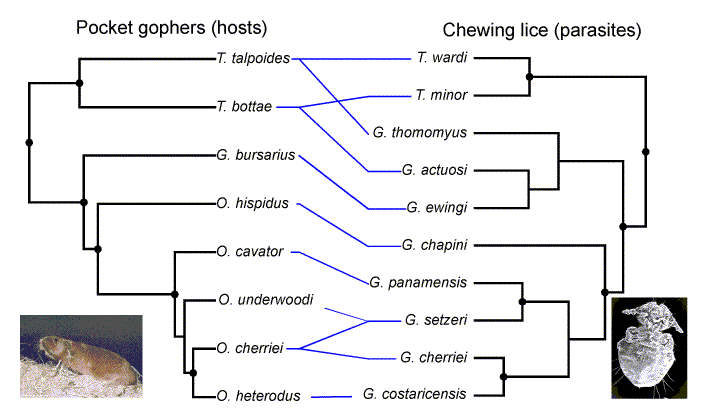
|
Cospeciation is the process whereby one population speciates in response to and in concert with another, and is a consequence of the associates dependence on its host for its survival. If this occurs for all instances of speciation by the host, the associate and host phylogenies would be topologically identical. This notion was formalised by Fahrenholz in 1913, however, in almost all instances of cospeciation, except those cases where the host is pathologically dependent on its associate, this principle is rarely strictly adhered to. Exceptions to a strict interpretation of Fahrenholz Œs rule are revealed by topological incongruence between the host and associates phylogenies. Consequently Farenholtz‚s rule is an important methodological tool for reconstructing the history of cospeciation between hosts and their associates. Nevertheless, it should be interpreted carefully as there are several additional explanations of congruent and incongruent host-associate phylogenies which must be recognised before cospeciation can be assumed to be the predominant pattern.
Lice are in many respects an ideal parasite to test macroevolutionary ideas concerning cospeciation. By comparing the phylogenies of lice and their hosts we can assess the congruence between the host and parasites shared evolutionary history. In the example shown above Hafner and Nadler looked at the host-parasite associations of eight species of pocket gopher (Geomyidae) and their Ischnoceran lice. Their phylogenies were reconstructed using gel electrophoresis to provide a measure of the distance between speciation events that it probably proportional to time. Both the branching pattern and branch lengths of these phylogenies form near mirror images of each other, suggesting that the lice have cospeciated with their hosts. In this instance deviations to the pattern are attributed to instances of host switching in which a louse from one host has switched to a non-ancestral host.
Over the past decade advances in the way congruence between different phylogenies is assessed has paved the way for new and more meaningful studies on the coevolution of associates and their hosts. However, the shortage of accurate phylogenies for both hosts and associates means that rigorous testing of hypotheses of cospeciation for many taxa await the elucidation of their phylogeny.
Title Illustration
Tanglegram showing host parasite associations between pocket gophers and their chewing lice (modified from Hafner, M.S. & Nadler, S.A. (1988) "Phylogenetic trees support the coevolution of parasites and their hosts." Nature 332: 258-259)
Pocket gopher photo from Sevilleta LTER mammal page
Gopher louse SEM copyright © 1996, Jim Demastes and Mark Hafner.



 Go to quick links
Go to quick search
Go to navigation for this section of the ToL site
Go to detailed links for the ToL site
Go to quick links
Go to quick search
Go to navigation for this section of the ToL site
Go to detailed links for the ToL site